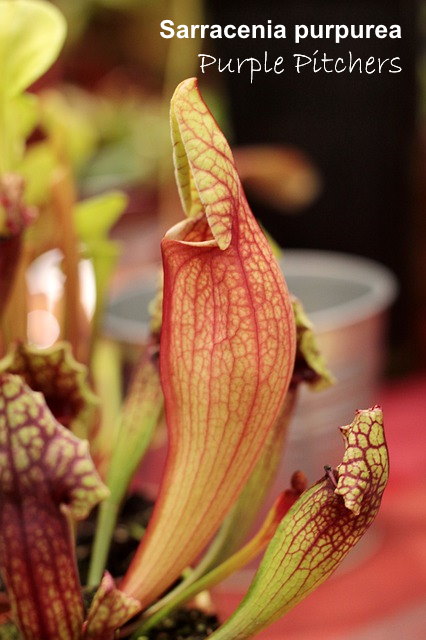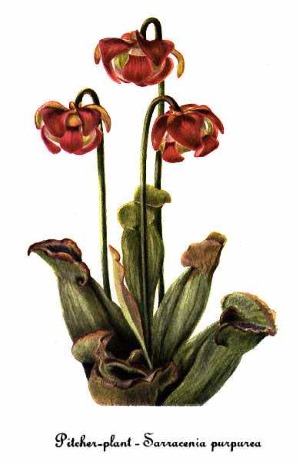Purple Pitcher Plant
Botanical Name: Sarracenia purpurea
Purple Pitcher Plant is native to swampy, humid regions of North America and is an unusual carnivorous plant you can grow indoors.
 Sun exposure causes red-purple veining. Photo: Sonja Kalee
Sun exposure causes red-purple veining. Photo: Sonja KaleeUpright leaves are tubular, the tops slightly bent over like a hood. These "pitchers" contain sweet juices that lure insects. Once an insect is inside, it is unable to escape the slippery slope and is digested by the plant's juices.
Pitcher colors and shapes vary by subspecies. S.p. venosa has dark purplish-red pitchers and bright green hoods with prominent purplish-red veins. S.p. purpurea is mostly purplish red with some green on the inside.
Mature plants will send up flowers in summer. And they are spectacular -- nodding umbrellas rising above the pitchers on tall stems. Flowers are made up of 5 petals and 5 sepals and may reach up to 3 inches (7 cm) wide. Bloom colors vary by subspecies and may be dark red, purple or pink.
Caring for Purple Pitcher Plants Year-Round
No blooms? If you bought a young plant at the store, you won't see flowers on it for a few years. Be patient.
Repot only when pitchers become too crowded. Use a wide pot to make room for growth.
Because of its unquenchable thirst, it's a good idea to pot Sarracenia purpurea in a shallow pot with drainage holes and place it in a saucer. Go ahead and water from the top, allowing the water to flow through the pot. You won't need to empty the saucer -- Purple Pitcher Plant will drink that up, too.
Winter care. Purple Pitchers may go dormant in winter. Water just enough to keep the potting medium barely moist, but don't allow it to dry out completely. Cooler winter temps will suit them, but do not expose Keep them in bright light/direct sun year-round.

Purple Pitcher Plant Care Tips
Origin: East Coast of the US and Southeastern Canada
Height: Leaves 6-in (15 cm); Flowers up to 1 ft (30 cm)
Light: Purple Pitchers thrive in bright locations with some direct sun. Sunlight will deepen the red/purple color of their leaves.
Water: Water generously throughout the growing season, keeping the soil evenly moist. Use rainwater or distilled water because the chemicals and minerals found in tap water will harm the plant. Never allow the potting mixture to dry out.
Humidity: Moderate to high (above 50% relative humidity). Set the plant on a humidity tray to raise the moisture around it.
Temperature: Cool to average room temperatures 60-70°F/16-21°C. Sarracenias will tolerate a minimum of 40°F/4°C in winter.
Soil: Sarracenia purpurea needs a medium that's free of nutrients and allows good drainage. Use a mixture of 1 part sphagnum peat moss and 1 part perlite or horticultural sand. DO NOT use potting soil or compost because it will kill the plant.
Fertilizer: Do not fertilize.
Propagation: Divide plants when they are crowded in the pot. Or sow seeds in spring.


